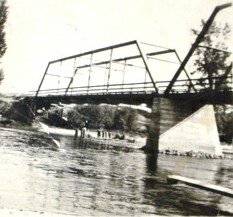Missoulian, Letter-to-Editor by Fred Stewart
Commissioner Jean Curtiss
Commissioner Bill Carey
Commissioner Michele Landquist
Dear Commissioners:
A loosely knit group of citizens concerned about the future of the Maclay Bridge and a proposed replacement bridge located on the west end of South Ave. has formed to be engaged with you as you consider this project. The Maclay Bridge Alliance (MBA) is strictly an ad hoc group, non-partisan, not affiliated with any other group or organization, open to any citizen.
Through information about the proposed replacement bridge gleaned from the records in the Missoula Public Works office (including inspection reports from 2002 to 2010), from listening in on conference calls and attending meetings and briefings with your office, we have concluded that the most basic and fundamental questions are being overlooked. Is there a need for a replacement bridge? Can Missoula County and the Missoula community, financially afford such a bridge, given other more pressing transportation infrastructure needs such as the Russell and 3rd Street reconstruction project? Since MDT bridge inspection reports indicate no significant increase in traffic using this bridge since 1997, what is the justification for replacement?
We understand that the Maclay Bridge Environmental Assessment (EA) that was done in 1994 analyzed various locations for a replacement to the Maclay Bridge. The selected location at the west end of South Ave. is indeed the most obvious place to locate a replacement, but the question of need was never addressed, nor was it included as part of the study. There was no record of decision from that study, so there is really no basis for putting the replacement bridge on the out-year budget for construction in 2016. Any attempt to base the bridge construction on an incomplete EA from 1994 would certainly be challenged.
You have noted in previous correspondence with members of our group that the National Bridge Database indicates the Maclay Bridge is “Structurally Deficient.” Shane Stack with Montana Department of Transportation (MDT) has told us by email that the National Bridge Database “from my understanding is not an official government website” and he suggested we use a MDT website that has the most current information. He pointed out that “problems with the deck led to the structurally deficient classification back in 2002, however in 2003 the County did make improvements to the deck, and the bridge is now classified as ‘functionally obsolete’.” This rating merely reflects the fact that the bridge is single lane, not that there is any safety issue related to the current use of the bridge. Residents who use the bridge on a regular basis (both city and county residents) experience minimal delays of less than two minutes at even the busiest times of the day. You need to compare this situation with traffic needs such as previously referenced that affect thousands of residents.
We are all aware of the tight budget times for the city and county. As Commissioner Curtiss stated in the Missoulian article on January 7, 2011, “The budget will be a hot topic in 2011, when the economic downturn catches up with Missoula County. This is going to be the year we have to make budget cuts – or raise taxes,” Curtiss said flatly. Even though there may be state and federal money to pay for construction of a replacement bridge, the discussions we have listened to indicate that the county would be responsible for construction costs of the approaches which will be in the millions of dollars.
We request, again, that discussion of the proposed Maclay Bridge project be an agenda item at your regular Wednesday BCC meeting. We strongly urge that you request that MDT perform a feasibility study of the need and cost of the proposed replacement bridge PRIOR TO spending any more time or money on the study that is currently under way and BEFORE signing the MOA currently being drafted. As currently written the MOA is “an agreement for the replacement …of the Maclay Bridge” which indicates that the decision to build a replacement bridge has already been made.
There have been no public discussions regarding either the replacement bridge, or issues that will lead to the need for an expensive EIS. Issues that imply the need for an EIS include impacts on wetlands and riparian areas; effects of increased traffic, including traffic funneled past the Target Range School, Big Sky High School, Community Hospital, the proposed Regional Recreational Park and the increased congestion at the intersection of South Avenue and Reserve Street; construction and maintenance costs for both the bridge and approaches; impacts on designated critical Bull Trout habitat; significant opposition by residents; and finally, the costs and impacts of future improvements on South Ave., Big Flat road and Blue Mountain road that would be required once a bridge on South Ave. is constructed. Would the revenue for these upgrades come from SIDs, county-wide tax increases, state or federal funds?
In conclusion we request time on the BCC agenda to discuss the need for a feasibility study before any more funds are spent on the MOA or the study that is currently in process. We have discovered feasibility studies have been used successfully by MDT, and the Director, Jim Lynch, has extensive experience with the process. As we understand it, a citizen group composed of stakeholders and transportation officials would analyze the facts and potential impacts to decide whether the project has merit. Our group requests the Commission pursue this process with MDT. It has been effective with projects dealing with environmentally sensitive issues and public discontent. We await a response to our requests. Please contact me and I will pass the information on to other members in our group.
Sincerely,
Fred Stewart (MBA, Co-Director)


 (Thank you to Walt, Lydia Maclay and Peggy Maclay Gadbow for sharing their precious family stories for an accurate account of events.)
(Thank you to Walt, Lydia Maclay and Peggy Maclay Gadbow for sharing their precious family stories for an accurate account of events.)